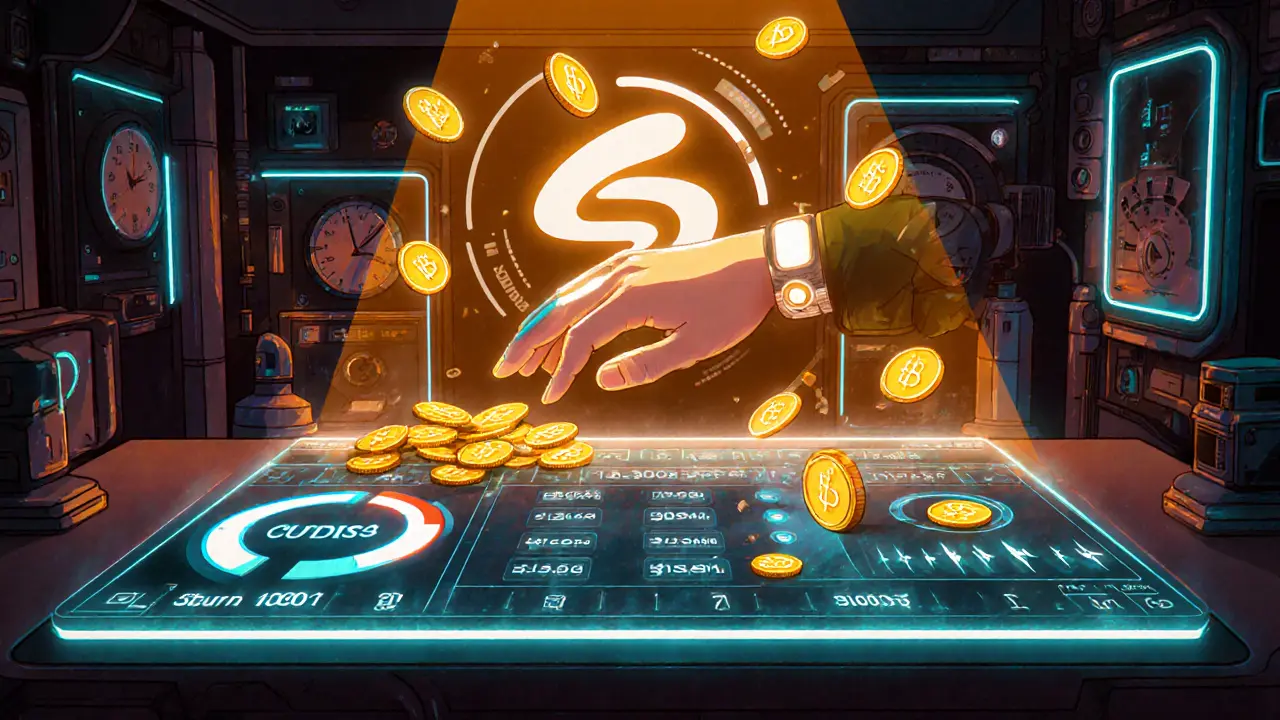What is CUDIS (CUDIS) Crypto Coin? The Solana-Based Longevity Protocol Explained
 Nov, 2 2025
Nov, 2 2025
CUDIS Sweat Mining Earnings Calculator
Calculate Your Daily Earnings
Estimate how many CUDIS tokens you could earn by tracking your health activities. Based on current token values and reward rates.
Your Daily Earnings
The CUDIS protocol pays users for verified healthy behaviors. Your earnings are based on real biometric data from the CUDIS Ring and AI analysis.
CUDIS isn't just another cryptocurrency. It's a wearable device, a health app, and a blockchain economy rolled into one - all built on Solana. Launched in 2024, CUDIS (CUDIS) positions itself as the world's first longevity protocol, promising to help users extend their healthy lifespan to 140 years. That’s not a marketing gimmick - it’s the core promise behind a $5 million funded project backed by Draper Associates, Skybridge Capital, and the Solana Foundation.
How CUDIS Works: Wearables, AI, and Crypto Rewards
CUDIS operates through three main pieces: the CUDIS Ring, the Longevity Hub AI platform, and the Super App. The ring is a smart wearable that tracks your sleep, heart rate, activity levels, and other biometrics. But unlike Fitbit or Apple Watch, it doesn’t just show you data - it pays you for it.
Every time you sleep well, walk 10,000 steps, or hit a workout goal, the system verifies it through the ring and rewards you with CUDIS tokens. This is called sweat mining. It’s not just about moving more - it’s about improving measurable health outcomes. The AI in the Longevity Hub analyzes your data over time and gives personalized feedback: better sleep hygiene, optimal recovery windows, nutrition tweaks. All of this ties directly into your token earnings.
The Super App is where everything comes together. You can spend your CUDIS tokens on premium supplements, book virtual consultations with doctors through Klarity Telehealth, or even buy exclusive NFTs from partners like Roger Dubuis and Lamborghini. You can also stake your tokens for passive income or vote on future features - governance is built into the token.
The CUDIS Token: More Than Just a Currency
The CUDIS token (CUDIS) runs on Solana, which means transactions are fast and cheap - under $0.00025 per trade, and 65,000 transactions per second. That’s critical because micro-rewards for daily health habits need to be instant and affordable.
Here’s what the token actually does:
- Sweat Mining Rewards - Earn tokens for verified healthy behaviors.
- Data Monetization - Sell anonymized health data to researchers through smart contracts. You get paid; they get real-world data.
- Premium Services - Pay for AI health coaching, personalized supplements, or advanced diagnostics.
- Staking & Governance - Lock up tokens to earn more and vote on ecosystem upgrades.
- Ecosystem Funding - A portion of token usage funds new health dApps and research partnerships.
Unlike Sweatcoin, which rewards steps with a limited digital currency, CUDIS gives you real economic power. You’re not just tracking your health - you’re building a financial asset from it.
Real Numbers: Who’s Using It?
CUDIS isn’t theoretical. As of October 2024, over 20,000 CUDIS Rings have been sold, generating $6 million in revenue. More than 200,000 people are using the app daily. The token’s circulating supply is 250 million, with a price around $0.04 USD. Its all-time high was $0.179 - a 350% spike fueled by rumors of a Coinbase listing.
Trading volume hits $4.5 million daily, making it one of the more active health-related tokens on Solana. Partnerships with Jupiter, Magic Eden, Worldcoin, and VitaDAO show it’s gaining real traction in the crypto-native community.
Who Backs CUDIS? Big Names, Big Money
The team behind CUDIS includes serial entrepreneurs from Google, Binance, Samsung, and Microsoft. They’ve been in crypto since 2016 and have exited previous ventures successfully. Their credibility isn’t just in code - it’s in execution.
The $5 million seed round was led by Draper Associates, the same firm that backed SpaceX and Tesla. Other investors include Skybridge Capital, NGC, Foresight Venture, and SNZ. The Solana Foundation also granted them funding - a rare endorsement that signals confidence in their technical execution.
Partnerships aren’t just for show. UCLA is involved in validating the health metrics and algorithms. That’s not marketing fluff - it’s academic validation. Roger Dubuis and Lamborghini aren’t just branding partners; they’re helping position the ring as a luxury wellness tool, targeting high-net-worth individuals who care about longevity as much as status.
Why Solana? Speed, Cost, and Scalability
CUDIS could have been built on Ethereum. But Ethereum’s high fees and slow speeds would’ve killed the model. Imagine earning $0.02 for a good night’s sleep - and paying $1 in gas fees to withdraw it. That’s not a reward. It’s a tax.
Solana solves that. With near-zero fees and instant confirmations, micro-rewards become viable. It also enables complex smart contracts for data monetization and governance. No other blockchain currently offers this combo of speed, cost, and scalability for a health economy.

Big Risks: Regulation, Science, and Adoption
For all its ambition, CUDIS walks a tightrope.
Regulatory risk is huge. Selling health data - even anonymously - triggers HIPAA in the U.S. and GDPR in Europe. If the platform makes claims about extending lifespan or curing conditions, it could be classified as a medical device. That means FDA approval - a long, expensive process.
Scientific skepticism is real. No one has proven that human health-span can be extended to 140 years. While some longevity researchers believe it’s possible in the distant future, CUDIS’s marketing leans heavily on that claim. That could backfire if regulators or scientists call it pseudoscience.
Adoption is another hurdle. Most people use Fitbit to see their steps. Few understand crypto. Convincing non-crypto users to buy a $299 ring, download an app, and start earning tokens is a massive behavioral shift. The luxury branding helps, but it’s still a tough sell.
Is CUDIS Worth It?
If you’re already into health tracking, crypto, and Solana - CUDIS is one of the most interesting projects out there. You’re not just buying a ring. You’re investing in a new kind of economy: one where your daily habits pay you back in real value.
If you’re skeptical about crypto or think longevity claims are hype - then CUDIS might feel like a gamble. But the team has real experience, real funding, and real partnerships. They’re not building a meme coin. They’re building a health infrastructure on blockchain.
Right now, the CUDIS Ring is available only through their website, with free global shipping. Buying one gives you access to token airdrops, cash prize pools, and exclusive events. It’s not just a device - it’s an invitation to a new health economy.
Whether CUDIS becomes the future of wellness or fades into crypto history depends on one thing: Can they prove their system actually makes people healthier - and for long enough to matter?
Frequently Asked Questions
What is the CUDIS token used for?
The CUDIS token is used to earn rewards for healthy behaviors, pay for premium wellness services, sell anonymized health data to researchers, stake for passive income, and vote on platform decisions. It’s the fuel for the entire CUDIS health economy.
Can I buy the CUDIS Ring anywhere besides the official site?
No. The CUDIS Ring is only available through the official website, cudis.xyz. Third-party sellers may exist, but they’re not authorized, and you won’t get access to token rewards, airdrops, or customer support.
Is CUDIS a scam?
It’s not a scam in the traditional sense - it has real funding, real partners, and real users. But the claim of extending life to 140 years is unproven and controversial. The project is high-risk, high-reward. Do your own research before investing time or money.
How does sweat mining work?
Sweat mining means earning CUDIS tokens by meeting verified health goals - like sleeping 7+ hours, walking 10,000 steps, or maintaining a steady heart rate. The CUDIS Ring tracks this data, the AI confirms it’s legitimate, and tokens are sent to your wallet automatically.
Does CUDIS work with Apple Watch or Fitbit?
No. CUDIS only works with its own proprietary CUDIS Ring. The ring has custom biometric sensors and firmware designed to communicate directly with the Solana blockchain. Third-party wearables can’t integrate with the system.
What’s the price of CUDIS right now?
As of October 2024, CUDIS trades around $0.04 USD, with a 24-hour trading volume of over $4 million. Prices fluctuate based on market sentiment, news, and token unlocks. Check CoinMarketCap or CoinGecko for live data.
Can I stake CUDIS tokens?
Yes. Staking is built into the Super App. You can lock your tokens to earn additional CUDIS over time. Exact APY rates aren’t public yet, but staking also gives you voting rights in governance decisions.
Is CUDIS available on Coinbase or Binance?
As of now, CUDIS is not listed on Coinbase or Binance. It’s traded on decentralized exchanges like Jupiter and Raydium on Solana. A potential Coinbase listing caused a major price spike in October 2024, but no official announcement has been made.
What’s the difference between CUDIS and Sweatcoin?
Sweatcoin rewards steps with a limited-use digital coin that can only be spent in its own marketplace. CUDIS uses a real cryptocurrency on Solana with multiple uses: staking, governance, data sales, and payments. CUDIS also tracks deeper biometrics and integrates with healthcare providers, making it more than just a step counter.
Does CUDIS have a whitepaper?
Yes. The full technical documentation, including tokenomics, AI architecture, and partnership details, is available on the official CUDIS website, cudis.xyz. The whitepaper is written for both technical and non-technical audiences.